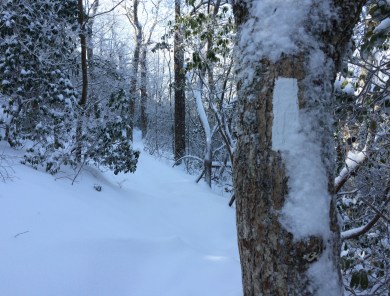Shenandoah National Park, VA, August 15-17, 2015 — I now coordinate five ridgerunners who patrol the 240 miles of the Appalachian Trail (AT) for which the Potomac Appalachian Trail Club (PATC) is responsible. While I am a volunteer, they are paid a modest stipend for their summer work.
Over the next couple of weeks I will be walking a bit with each of the five. My objective is to know them better and learn what I can from them about the issues on their respective sections of the trail. Afterall, we’re expecting many more hikers next year. http://appalachiantrials.com/a-walk-in-the-woods-and-its-impact-on-the-appalachian-trail/
Last weekend I walked a section with Lauralee Bliss who is the sole ridgerunner for all 105 miles of the AT in Shenandoah. That’s a lot of territory to cover. To say her hiking resume is strong is an understatement. A former orthopedic nurse, she has thru hiked the AT both northbound and southbound. Her memoir of those hikes, Mountains, Madness, & Miracles: 4,000 Miles Along the Appalachian Trail sells well. She also has published more than 20 books. http://www.amazon.com/Lauralee-Bliss/e/B001JPCEBI
Lauralee’s multi-year tenure and the volume of unsolicited praise from hikers pretty much says it all. I’d heard a lot of good things about her long before actually making her acquaintance at a National Trail Day event earlier this summer.
Last Saturday, after completing my work with PATC’s North District Hoodlums trail crew, I hiked in to meet Lauralee at Black Rock hut located at northbound mile 882.3 on the AT. From there we would hike to McCormick Gap at mile 865.3 with a second overnight stop at the Calf Mountain hut in between.
Along the way we swapped ridgerunning stories and performed minor trail maintenance including clearing some minor blowdowns and picking up micro trash.
Our first adventure happened bright and early the first morning. We stopped to snag the TP someone had left next to the deposit they’d plopped just a couple of feet off the trail. As Lauralee shed her pack with intentions of parking it, I noticed a copperhead lolling in the leafy landing zone, perfectly camouflaged as they are. When ole “Jake No Shoulders” slid into a new residence amongst the discarded TP we decided let it be and wait for another time, discretion is the better part of valor you know. That’s the only mess we didn’t clean up.

Lauralee checking in with Shenandoah dispatch. Many ridgerunners are issued radios that connect them to the various forms of support they need. She’s standing next to Skyline Drive which is the primary front country feature of Shenandoah National Park.
The first day was a hot one. Toward the end, my IT band was talking back loudly and with authority, but what the hey, it’s all in a day’s work. At one point I saw a branch strangely sticking out of the ground and partially blocking the trail. I judged it to be a tripping hazard. Wrong! It was plugging a yellow jacket nest.
I got lucky. When I yanked it out only a few of the evil little critters buzzed about to take a gander. Rather than luck, it could have been professional courtesy since I used to work at Georgia Tech. Whatever the reason, I’ll take it. (The Georgia Tech mascot is “Buzz” the Yellow Jacket.)
Along the way we heard about a boisterous southbound Boy Scout troop which had camped at the Calf Mountain hut. Negative reputations travel fast on the AT. We didn’t know what to expect, but experience has taught each of us not to hope for much. We weren’t disappointed, though it could have been much worse.

Trash left by the Boy Scout troop. We only wish they had signed the shelter register. We love return addresses when we find trash. The pot was full of uneaten food.
Lauralee’s purpose for bringing me to this section was for me to see where maintenance is needed. Some parts of this section are overdue for weeding. Weeding is important because weeds are the vector for Lyme disease-bearing deer ticks. http://distancehiking.com/blog/lyme-disease-appalachian-trail/

A contractor mows parts of this section since its distance from population centers makes recruiting overseers difficult. The vegetation alongside the trail is an invasive species called Japanese stilth grass. Stealth grass would be more like it. The stuff sneaks right up on you with overwhelming force!
Many hikers want to become ridgerunners because they think the job is about hiking. It’s actually about education. The purpose of ridgerunning is to help hikers do the right things to take care of the trail and its surrounding environment.

Ridgerunners help hikers understand how to “Leave No Trace” that they’ve ever been in the wilderness. https://Int.org .

Best of all, ridgerunners help hikers. Here Lauralee helped this young college student with a pack shakedown that eliminated eight excess pounds of equipment that she did not need.
One thing I learned about Lauralee is that she is a bear whisperer. On our last morning we found a young bear ambling in the forest. It probably is his rookie year away from his mother.
When Lauralee talked to the bear in her soft blissful voice, his head cocked from side to side while his ears twitched in every direction like radar searching for UFOs. Maybe to him that’s what we were.
I just know this: He left us with a gentle heartbeat and in the good spirits that reflected the extraordinary person with whom I was fortunate enough to share the weekend.






















































































